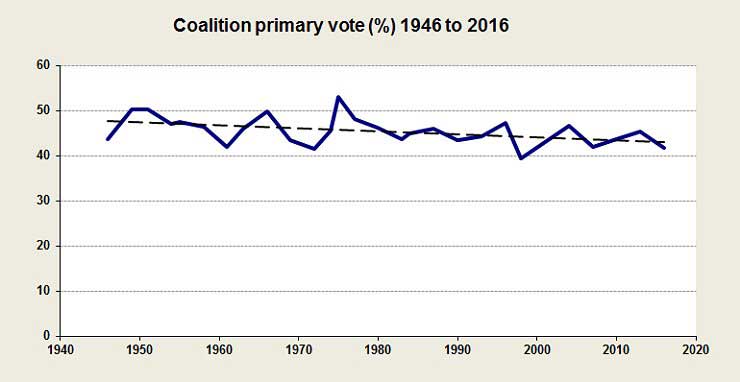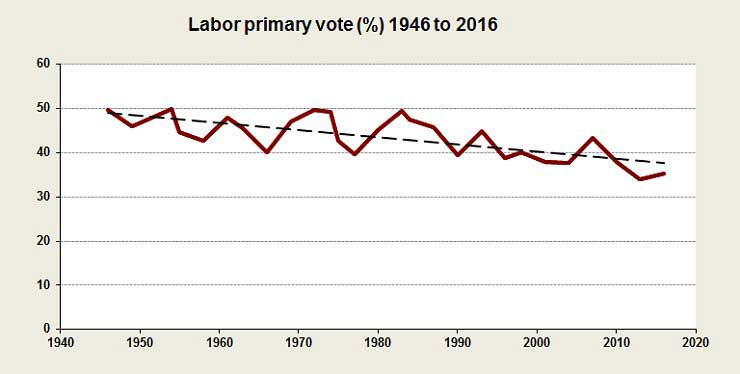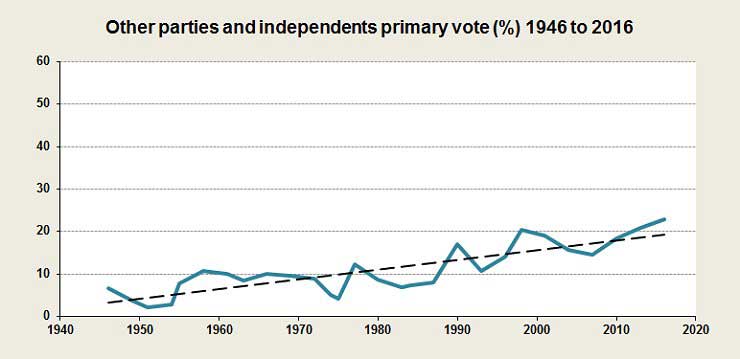Last night’s result – or so far lack thereof – is a sign that the major political parties are staring down the barrel of change. Ian McAuley explains.
By the end of counting, with 78 per cent of votes tallied by Sunday morning, the ABC election website showed Labor with 67 seats, the Coalition with 65 seats, other parties with 5, and 13 seats in doubt. To form a bare majority without depending on some support from those other parties, Labor would have to win nine of those thirteen seats and the Coalition would have to win eleven of them.
On the expectation that postal votes are likely to favour the Coalition strongly, Turnbull and Liberal Party strategists believe the Coalition will get over the line – at least that is what they’re saying in public (Joshua Dabelstein’s article this morning on Turnbull’s ‘crystal balls’ gives a more honest picture of the thinking in the Coalition ranks).
In his post-midnight speech, full of confidence and bluster, Turnbull drew attention to the 1998 election, when the Howard Government lost the two-party vote to Kim Beazley but scraped in with a bare majority, and went on to hold office for another nine years.
On that occasion, however, Howard had a comparatively united party (there was no dumped prime minister on his back bench), the Senate was reasonably friendly, and the economy was growing strongly, with revenue pouring into the Government’s coffers. This time economic growth is weak, and there are risks of a fall in housing prices, a sharp slowdown in China, and continued shockwaves from Brexit.
At this stage, it is impossible to predict what will emerge once the polls are declared. But whatever happens, we are in for a period of political instability and there will be plenty going on to keep the mainstream media focussed on short-term political issues.
Expect to hear a lot more about a “hung parliament”, as if yet again we are to be afflicted by a quirk that defies the natural laws of politics.
But there is a longer-term development suggesting the days of a two-party Westminster system are behind us. That can be shown in three graphs.
First, the Coalition’s primary vote, going back 70 years to the 1946 election when the Liberal Party re-emerged on the landscape:

There is a distinct downward trend over the 70 year period. The Coalition’s high point was in 1975, the election following the dismissal of the Whitlam Government. Since then the decline in the Coalition’s primary vote has been steeper.
I suspect that the Liberal Party strategists don’t see this trend. The Howard Government’s run of good luck from 1996 to 2007, their “born to rule” mindset and their ingrained belief in their own economic competence shields them from seeing their party’s decline. As for the National Party, even though population shifts are slowly wiping them out, their confidence will have been boosted by their taking a seat from the Liberals in this election.
Just as some people (over-represented in the Coalition) when presented with a time series on climate change can be predisposed to deny evidence of a trend, this electoral trend is easy to ignore.
That brings us to Labor’s primary vote:

Labor’s decline is notably steeper than the Coalition’s.
There’s certainly more awareness of this trend – on Saturday night Scott Morrison, scratching around for good news, kept reminding listeners that Labor was recording its second-lowest primary vote on record.
To return to the climate change analogy, the risk for Labor is that, just as those who deny the trend in climate change cite recent events such as an abnormally cold winter to support their view, Labor will be distracted by their recovery in their primary and two party preferred vote, and by their impressive gain in seats won.
The picture is completed by the vote for other parties and independents:

In terms of seats in the House of Representatives there may be no net gain, with Clive Palmer’s seat of Fairfax returning to the Coalition off-setting Rebekha Sharkie’s win in Mayo.
But even if Xenophon and the Greens pick up no more seats, their performance in terms of primary votes won has been impressive, and the Greens could easily win a swag of seats at the next federal election, such is their strong vote in urban and coastal seats.
Tony Windsor and Robert Oakeshott didn’t achieve their upset wins, but they have put in a strong showing, and in Indi Cathy McGowan improved her vote, in spite of both Coalition parties having a go at the seat.
These figures relate to the House of Representatives. It will be some time before a clear picture of Senate voting emerges. Derryn Hinch and Pauline Hanson both have quotas, and it is probable that the Senate will have even more representatives from “shrapnel parties”, which have been favoured by a double dissolution (when historians look back on this election, Turnbull’s decision to call a double dissolution election will be the strongest sign of his over-confidence).
The only clear result is that the days of a Senate compliant with the wishes of executive government are long behind us: in the last 50 years, only in three brief periods has the government had a Senate majority.
The emerging picture is that the Westminster-style two-party system of government is getting to be past its use-by date, but that will take some time to sink in.
When external changes threaten the survival of old institutions their first reaction is usually denial, followed by a strong defence of the existing order. The Coalition’s full-page election-eve advertisements in the daily papers (an old medium), warning of a “hung parliament” read like a Kodak advertisement warning of the risks of digital photography.
It’s not only the established parties that are in denial. On Thursday before the election, a group of senior executives from some of Australia’s largest firms – a group who normally confine their political utterances to the discreet safety of the Melbourne Club – came out in public to warn of the danger of a “hung parliament”. The ABC’s idea of “balance” is designed for a two-party system, and its journalists have been speaking of a “hung parliament” as if it’s some dysfunctional aberration.
Political pundits still talk about “crossbenchers” in the House of Representatives, as if it’s a perversion to have more than two parties in the chamber.
Contrary to many people’s assumption, there is nothing in our Constitution that says we have to be governed by a two-party Westminster system, and our early parliaments were certainly not simple two-party affairs. The term “hung parliament” is not in common use in other democracies.
Where Australia goes from here is not clear – there are too many plausible scenarios. We may be on the path to a multi-party democracy where parties in the centre form loose coalitions to the exclusion of those on the fringes, as is the case in many European countries, most notably Germany.
Labor, once it gets over its Saturday night exuberance, may understand that it still needs to reform and modernise itself.
In the short term, it appears that the Coalition will form government, most probably without an absolute majority, but on the basis of holding more seats than Labor and not facing a no-confidence vote.
If Turnbull turns out to have an as-yet unrevealed political deftness and a capacity to understand long-term trends, he will reach out to Labor and the Greens to develop a consensus around major aspects of economic policy.
If he digs in to the idea of a “mandate”, as he and Morrison were suggesting on election night, he will face a tough parliamentary and party-room battle, particularly if the opinion polls turn unfavourable (quite likely if there is an economic downturn).
One possible outcome is that the Coalition may come apart, with a new far-right party coalescing around the National Party and disaffected Liberal Party members, and although they may not think so now, that may be the best thing that could happen to the Liberal Party.
The only thing we can be reasonably sure of is that it will be some time before politicians in the major parties realise that their world is changing.
Donate To New Matilda
New Matilda is a small, independent media outlet. We survive through reader contributions, and never losing a lawsuit. If you got something from this article, giving something back helps us to continue speaking truth to power. Every little bit counts.





